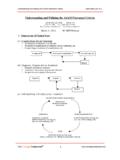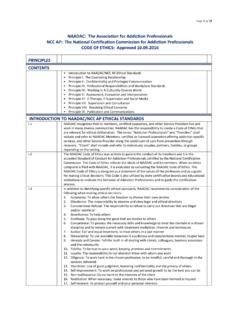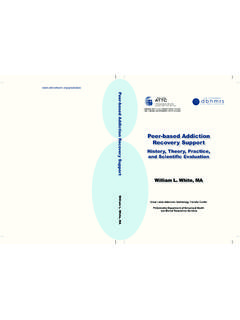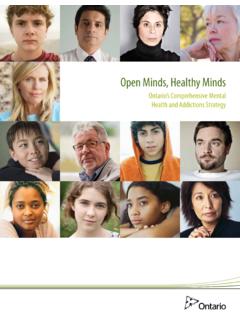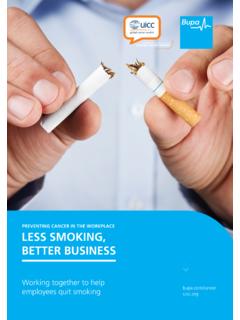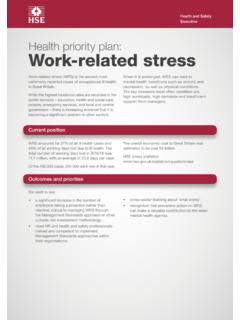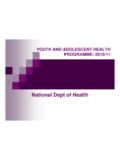Transcription of The ASAM Criteria
1 What's New in The ASAM Criteria Treatment Criteria for Addictive, Substance-Related, and Co-Occurring Conditions David Mee-Lee, MD. Chief Editor of The ASAM Criteria Board-certified psychiatrist ABAM certified Sr. Vice President of The Change Companies . The Six Dimensions of Multidimensional Assessment At a Glance: The Six Dimensions of MultiDimensional Assessment The ASAM Criteria structures multidimensional ASAM's Criteria uses six dimensions to create a holistic, biopsychosocial assessment of an individual to be assessment around these used for service planning and treatment across all services and levels of care. The six dimensions are: six dimensions to provide Acute Intoxication and/or Withdrawal Potential a common language of holistic, biopsychosocial 1 Dimension 1 Exploring an individual's past and current experiences of substance use and withdrawal assessment and treatment Biomedical Conditions and Complications 2.
2 Across addiction treatment, Dimension 2 Exploring an individual's health history and current physical physical health, and mental condition health services, which Emotional, Behavioral, or Cognitive Conditions and addresses as well the spiritual issues relevant in recovery. 3 Dimension 3 Complications Exploring an individual's thoughts, emotions, and mental health issues The six assessment Readiness to Change dimensions, briefly described here, are essentially the 4 Dimension 4 Exploring an individual's readiness and interest in changing same as in earlier editions of Relapse, Continued Use, or Continued Problem Potential ASAM's Criteria , with slight modifications to apply to 5 Dimension 5 Exploring an individual's unique relationship with relapse or continued use or problems co-occurring mental health Recovery/Living Environment conditions that were initially described in PPC-2R (2001)
3 6 Dimension 6 Exploring an individual's recovery or living situation, and the surrounding people, places, and things How to Use The ASAM Criteria -2- How to Use The ASAM Criteria -3- 888-889-8866 | Guiding Principles of The ASAM Criteria then and now 1 Beginning with the first edition of ASAM's Criteria , certain foundational concepts have continued through this edition and will no doubt serve as the foundation for any future developments. Similar to its prede- cessors, the following guiding principles serve as the basis for all content within The ASAM Criteria : Moving from one-dimensional to multidimensional assessment Moving from program-driven to clinically driven and outcomes-driven treatment Moving from fixed length of service to variable length of service Moving from a limited number of discrete levels of care to a broad and flexible continuum of care Identifying adolescent-specific needs Clarifying the goals of treatment Moving away from using previous treatment failure as an admission prerequisite Moving toward an interdisciplinary, team approach to care Clarifying the role of the physician Focusing on treatment outcomes Engaging with Informed Consent.
4 Clarifying Medical Necessity . Incorporating ASAM's definition of addiction What's New in The ASAM Criteria Brand new chapters new Terminology in The ASAM Criteria in The ASAM Criteria Application to Adult Special The individuals served in treatment are now most often referred to Populations as individual, person, participant, or patient, and these are used interchangeably in this publication Older Adults Book title and concept is now The ASAM Criteria . Parents or Prospective Parents Receiving Terms such as dual diagnosis and dual disorders are Addiction Treatment Concurrently with Their now described in the spectrum of co-occurring disorders or Children conditions . Persons in Safety-Sensitive Occupations Detoxification services are referred to in this edition as Persons in Criminal Justice Settings withdrawal management . Opioid Maintenance Therapy (OMT) is now discussed as Emerging Understandings of Opioid Treatment Programs (OTP) and Office-Based Opioid Addiction Treatment (OBOT) within Opioid Treatment Services (OTS).
5 Gambling Disorder Level : Clinically Managed Medium-Intensity Residential Treatment is now Level : Clinically Managed Population- Tobacco Use Disorder Specific High-Intensity Residential Services . Compatible with The ASAM Criteria Software Combining adult and adolescent treatment information Incorporation of the latest understanding of Co-occurring Disorders Capability Inclusion of the conceptual framework of ASAM's definition of Addiction and Recovery Oriented Systems of Care Further expansion on the role of the physician Updated Diagnostic Admission Criteria for the levels of care New chapters on gambling and tobacco use disorder An updated opioid treatment section Updates to better assess, understand and provide services for all six ASAM Criteria dimensions Revised terminology Reformatted levels of care numbers A user-friendly format -4- Co-Occurring Disorders applications 1.
6 Addiction Mental Co- issues Health Co-Occurring Occurring issues Condition Disorder Addiction Treatment Co-Occurring Capable Co-Occurring Treatment Enhanced Treatment Mental Health Treatment Co-Occurring Conditions and Co-Occurring Disorders refer to individuals. Co-Occurring Capable and Co-Occurring Enhanced refer to types of programs. Adolescent-Specific Criteria Adolescent-Specific Considerations: Co-Occurring Disorders It is increasingly recognized that comorbidity among adolescents with substance use disorders is the rule and not the exception. As in adults, the line between addiction treatment and mental health treatment is increasingly blurring, and the need for co-occurring enhanced, or combined behavioral health program- ming, is great. Although our evidence base for co-occurring treatment is limited compared to that for adults, it is growing. For example, there is mounting evidence that identifying and treating depression in substance-involved youth improves substance use outcomes, and vice versa.
7 Another example is our grow- ing awareness of the psychiatric sequelae of marijuana use in youth, and our growing clinical suspicions that these problems are much worse with synthetic cannabinoids ( K2, spice, etc.). As more knowledge emerges, future editions of the Criteria should incorporate it to support clinical decision making. Relevant Areas of Integration A. A A MH. Integration of substance Integration of primary Integration of addiction use services into primary health into addiction and mental health services health care treatment settings in a variety of settings A major advance during the past decade has been the growth of capacity or capability to address mental health, sub- stance use disorder, and general health issues in integrated settings. This approach facilitates participant engagement and improves outcomes while using resources more efficiently.
8 Consequently, just as addiction programs have improved co-occurring capability (and thereby improved their ability to integrate attention to co-occurring issues within addiction settings), the same thing has been happening in other areas of the health care system as well. -5- 888-889-8866 | Levels of Care Level Adolescent Adult Title Description of Care Title Assessment and education for at-risk individuals who do not meet diagnostic Criteria Early Intervention Early Intervention for substance use disorder Less than 9 hours of service/week (adults); less than 6 hours/week (adolescents) for 1 Outpatient Services Outpatient Services recovery or motivational enhancement therapies/strategies six dimensions 9 or more hours of service/week (adults); 6 or more hours/week (adolescents) to 2 Intensive Outpatient Intensive Outpatient treat multidimensional instability 20 or more hours of service/week for multidimensional instability not requiring Partial Hospitalization Partial Hospitalization 24-hour care Clinically Managed Low-Intensity Clinically Managed Low- 24-hour structure with available trained personnel.
9 At least 5 hours of clinical Residential Intensity Residential service/week Clinically Managed Population- 24-hour care with trained counselors to stabilize multidimensional imminent *This Level of Care not designated for Specific High-Intensity danger. Less intense milieu and group treatment for those with cognitive or other adolescent populations Residential impairments unable to use full active milieu or therapeutic community 24-hour care with trained counselors to stabilize multidimensional imminent Clinically Managed Medium-Intensity Clinically Managed High- danger and prepare for outpatient treatment. Able to tolerate and use full active Residential Intensity Residential milieu or therapeutic community Medically Monitored High Intensity Medically Monitored Intensive 24-hour nursing care with physician availability for significant problems in Dimen- Inpatient Inpatient sions 1, 2 or 3.
10 Sixteen hour/day counselor ability Medically Managed Intensive Medically Managed Intensive 24-hour nursing care and daily physician care for severe, unstable problems in 4. Inpatient Inpatient Dimensions 1, 2 or 3. Counseling available to engage patient in treatment *OTPs not specified here for adolescent OTP Opioid Treatment Program Daily or several times weekly opioid agonist medication and counseling available to populations, though information may (Level 1) (Level 1) maintain multidimensional stability for those with severe opioid use disorder be found in discussion of adult services Tobacco Case Studies LEvel of Withdrawal Management for Level Description Case 6 Adults TH is a 50-year-old addiction counselor who works at a residential Mild withdrawal with daily or less than addiction treatment center. The center has decided that they are going Ambulatory Withdrawal Management daily outpatient supervision; likely to to begin treating tobacco addiction along with all other addiction.


